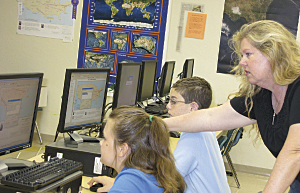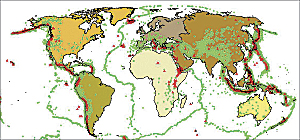Making the Grade
Florida's Palm Beach County School District Successfully Raises Academic Achievement
By Donna L. Goldstein, GIS Coordinator, Palm Beach County School District, Florida
Highlights
- GIS can easily be infused into existing curriculum, such as science and social studies.
- Integrating GIS into K–12 curriculum raises students' academic achievement.
- The benefits of infusing GIS into K–12 curriculum extend far beyond the classroom.
Traditionally, GIS has been used at the Palm Beach County School District in Florida at the operational or administrative level, in departments such as the facility management planning department, for demographic analysis, student population projections, boundary assignments, and school loading. However, in 2007, this author, the district's GIS coordinator and planning director, recognized the powerful potential of GIS as a teaching aid, and she also understood the overwhelming marketability of GIS skills and pursued the prospect of integrating GIS into the curriculum. The coordinator was aware of research indicating that integrating geospatial technologies into the classroom is beneficial, but she also knew that there had been no conclusive studies regarding the impact this instruction has on raising academic achievement test scores. She was up to the challenge of evaluating this.
The Palm Beach County School District is the twelfth largest school district in the nation. Contrary to popular belief, the county's population is composed mostly of middle and lower socioeconomic classes and has a very diverse student population. There are more than 170,000 students speaking 149 languages and dialects other than English, and more than 50 percent qualify for free and reduced-cost meals. The importance of utilizing Palm Beach County School District for this project lies in the diversity of the population, which is a microcosm of the nation and reflects national trends toward increased Hispanic and African American populations.
However, one of the elements both educators and administrators struggle with in education is validating the benefits of new, innovative applications, such as GIS. In general, because the focus is on high-stakes standardized test scores and class grades, it has been difficult to persuade policy makers to incorporate GIS into the curriculum.
Thus, it was necessary to convince school district authorities that integrating GIS into the already crowded existing curriculum would promote learning, including enhancement of students' critical thinking skills, analytic abilities, and communication skills, while helping raise academic achievement—the holy grail of education. Current educational reform mandates allow for little deviation from the prescribed curriculum; however, GIS can be infused into existing curriculum, such as science and social studies, and the GIS coordinator offered to train the teachers. Always cognizant of the ever-decreasing funding for K–12 education, they were able to dismiss stakeholders' financial concerns by obtaining the cost-effective site license solution for school districts offered by Esri.
GIS Project Charter
A business model approach to developing a collaborative team was utilized to promote broad involvement and begin expanding use of GIS technology into the classroom. In 2007, a GIS steering committee was formed that included membership from career academies, curriculum planning, educational instruction, information technology, facilities management, and school police. At the initial meeting, the committee was presented with the outline for the project charter, which aligned school district goals and objectives with the integration of GIS into existing curriculum. Discussion ensued, milestones were identified, and members were assigned roles and responsibilities.
With the educators on board, the district purchased GIS lesson plan books for middle and high schools—Mapping Our World: ArcGIS Desktop Edition, GIS Lessons for Educators (Malone, L., A. M. Palmer, C. L. Voight, E. Napoleon, and L. Feaster 2005). The social studies curriculum planner noted that the "tie-in with the ArcGIS Desktop lessons to national and state learning standards would be very beneficial." The lesson plans come complete with datasets, step-by-step instructions for using the ArcGIS Desktop software with the subject material, and assessment tools. These books were used for the teacher training, then leveraged in the classroom with the students. Utilizing this method provided a smooth transfer of knowledge, and teachers gained a comfort level with the new technology.

Teacher Susan Oyer with students.
The school district's GIS K–12 effort also had community involvement from GIS users in the business community. South Florida Water Management District and Palm Beach County government GIS users assisted with teacher training and also gave presentations to the students. The students gained valuable insight from these GIS professionals as to how GIS is used in the real world. The community partnerships that were formed reinforce the GeoMentor program goals introduced in 2009 by Esri, which are designed to offer educators assistance from GIS professionals.
Finding the Holy Grail
In an effort to provide a platform for expansion of GIS throughout the district, analysis was performed to measure test scores, including a comparison of high-stakes mandated tests of those students who had received GIS instruction versus those who had not. In addition, the students who had received GIS instruction completed a survey to help gauge whether they believed learning GIS helped raise their academic achievement and their overall perceptions of the program. The students used ArcGIS in the classroom to complete the GIS lessons.
The test score results support the students' overall perceptions that integrating GIS into the curriculum does in fact motivate and engage them in the learning process and, as suspected, raise their academic achievement. One of the most interesting findings was that all students who had GIS instruction improved their high-stakes comprehensive reading scores, with the most dramatic improvements being noted among the students who spoke English as a second language. When asked why reading scores increased, the teacher stated, "The students really wanted to complete the lesson and create the final map—it motivated them to read, reread, and comprehend the lesson material and instructions." Science and social studies grades improved as well; with science becoming such an important facet of this country's future, these results support the continued infusion of GIS into the K–12 curriculum.
Return on Investment—Extra Credit
The benefits of infusing GIS into K–12 curriculum extend outside the classroom. GIS integration will provide our youth with the technology tools needed to compete in an ever-growing global marketplace. With the emergence of geospatial technology in virtually every industry, students with GIS experience will be well equipped to enter a myriad of careers or vocational trades. In fact, the U.S. Department of Labor (Employment & Training Administration 2009) has said, "Because the uses for geospatial technology are so widespread and diverse, the market is growing at an annual rate of almost 35 percent, with the commercial subsection of the market expanding at the rate of 100 percent each year." Clearly, the U.S. government recognizes the tremendous growth and urgent need to develop a workforce aptly skilled in geospatial technologies. Educational reform can be adjusted to address the future economic and business requirements, thus ensuring our ability to compete at the global level. As our nation forges ahead to meet the needs of this ever-changing society, one way may be to infuse GIS into our educational system.
About the Author
Dr. Donna Goldstein has 30 years of GIS experience working in various industries, including engineering, architecture, planning, zoning, and building. She has held the position of GIS coordinator at Palm Beach County School District since 2001. She received her PhD in educational leadership and has a bachelor's degree in business administration. Goldstein has been instrumental in integrating GIS into existing K–12 curriculum.
For more information, contact Donna Goldstein, GIS coordinator, Palm Beach County School District, Florida (e-mail: donna.goldstein@palmbeachschools.org).
